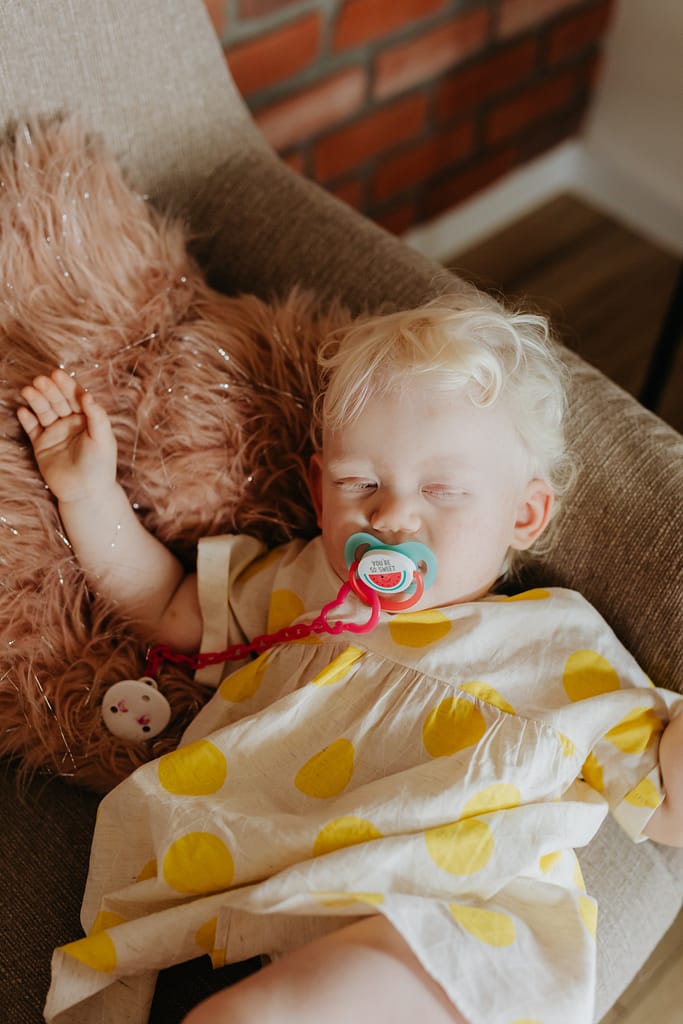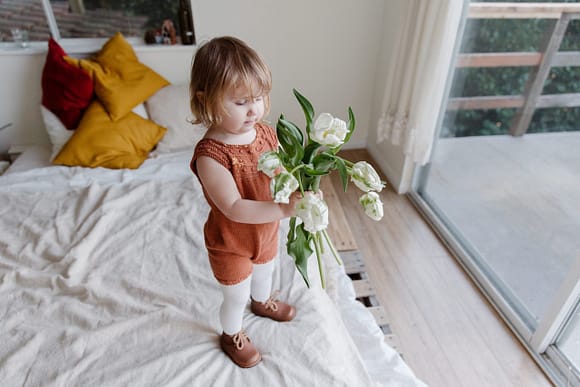Can you gentle parent and sleep train?
Think back to when you were a new parent.
What did you envision sleep training your baby to be?
More than likely – cue an unnerving scenario with nonstop crying and tears galore for hours.
And that’s for the baby and you.
Which is not exactly what you envision gentle parenting to be.
So can you be a gentle parent and sleep train your child?
Because right now, you’re doubting whether sleep training “fits” with gentle parenting.
You’re also exhausted from keeping this new person you love so much alive.
So something needs to give soon before you lose it!
If you’re wondering whether you can be a gentle parent and sleep train, you’re on the right blog post.
Keep reading to learn why it’s okay to sleep train your child even if you’re a “gentle parent.”
You’ll also learn a few tips to help your little one learn how to fall asleep on their own – all in a way that honors your gentle parenting style.
Disclaimer:
This page may contain affiliate links, and I earn a small commission if you make a purchase through one of the links at no cost to you. And as an Amazon Associate, I earn from qualifying purchases. I only recommend products I have personally vetted.
What is sleep training?
Sleep training is teaching your child to fall asleep without you.
Sleep training aims to get your baby comfortable with falling asleep – or back to sleep – on their own.
Is sleep training necessary?
Sleep training isn’t necessary, but it does afford weary parents more sleep.
If you’re exhausted and your baby is at least 4 months old, don’t feel guilty if you consider sleep training your child.
Similarly, don’t feel guilty if you don’t want to sleep train your child. Children learn to fall asleep independently because it’s wired in their brains.
You can teach your child good sleeping habits, like a solid bedtime routine, to help them along.
Is sleep training bad?
Sleep training is safe for babies when parents use compassion and understanding.
But lots of baby sleep training methods involve ignoring cries. Many recommend no or minimal touching, picking up, or feeding.
Are those sleep training methods good for your baby?
The answer isn’t so black and white, as some studies say sleep training causes no ill effects in infants.
Others suggest that controversial methods like “cry it out” undermine a child’s trust in the parent and release stress hormones.
Babies need tons of physical touch to thrive. So comforting them when they’re distressed isn’t “bad.”
If you’re struggling with the idea of sleep training as a gentle parent, try exploring how you feel about sleep training your baby.
You know your child, so trust yourself that you can embark on whatever journey you choose – and pivot if necessary.
Can you gentle parent and sleep train?
Gentle parenting is about holding empathy, understanding, respect, and boundaries with your child.
It’s possible to be a gentle parent and sleep train using an approach (or mix of methods) that works for you and emphasizes these points.
Tracy Hogg’s Pick Up Put Down method is a favorite among many gentle parents because it encourages them to respond to their child’s cries.
We did that with Wade, and I also read Elizabeth Pantley’s No Cry Sleep Solution for Newborns.
Beyond following a sleep training guide, it’s important to help your child learn healthy sleeping habits.
This may be the most important thing you can do because children often “relapse” on their sleep training progress via cut-and-dry sleep training approaches.
You can help your child by creating a consistent bedtime routine, making their room comfortable, and keeping a close eye on naps if your child is still taking them.
Depending on their age, you can drop that last nap of the day.
Keep reading to learn more about how to help your child learn to fall asleep on their own.
When can you start gentle sleep training?
Many pediatricians and baby sleep experts recommend that parents start sleep training when their baby is at least 4 months old.
Doctors recommend sleep training no earlier than 4 months because babies younger than that wake up more often and feed more.
It isn’t until 4-6 months that their circadian rhythm kicks in, and they sleep for longer stretches through the night and reduce night feedings.
How to gently sleep train your child
Gentle parenting and sleep training can go together.
Because you need sleep. The baby needs sleep.
So how can you sleep train your child in a way that feels more gentle, more compassionate – less ignore-your-gut-instinct?
You don’t have to follow a created schedule or method, like 5 3 3 or pick up, put down if you don’t want to.
And if you do, go for it.
Regardless, you can help ingrain healthy sleeping habits in your child by doing a few fairly simple things every day.
Try these 6 tips to get started on sleep training your tot:
1. Create a bedtime routine
A bedtime routine is a fantastic way to cue your child that it’s time for sleep.
And consistency matters when it comes to bedtime.
Kids with an established routine fall asleep faster, wake less, and sleep longer than children who do not have a bedtime routine.
Newborns get a pass, but babies and children feel safe with a routine, especially at bedtime.
It’s tempting to bring them along to your late-night dinner reservation, but they should be in bed – at least most nights.
Dinner, outside play, a bath, story time, then bed gets energy out and feel-good input in.
2. Make their room comfortable
While they should be sleeping in a cool, dark room, find what makes your child comfortable for a good night’s rest.
Take them to the dollar store to pick out a night light or stuffed animal.
Try a white noise machine or fan. You can also make your own glow-in-the-dark stars!
3. Reduce or shorten naps
Whether your baby is taking one nap or many naps during the day, don’t put them down again if it’s after 5 pm or less than 3 hours from their bedtime.
Depend on your schedule, not a book’s.
4. Focus on their diet
A tryptophan-rich snack after dinner and playtime helps your little buddy’s body get ready for bed.
Toast and peanut butter and cheese on a few crackers are healthy options.
Wade often enjoys a scoop of peanut butter before a bath.
5. Choose an approach that works for you
Don’t guilt yourself. Experiment with different approaches until you find your groove.
Remember, you and your baby are learning this – give yourself grace.
6. Wear headphones
One last tip for sleep training babies: wear headphones and listen to music to help you hear your baby’s cries a little less.
Especially for noise-sensitive Fibromyalgia parents, your baby’s cries rattle your entire body.
On days when I was overstimulated and trying to put Wade to bed (which, let’s be honest, was pretty much all the time as a postpartum mama with Fibro), wearing headphones and listening to music helped drown out his cries.
I’d be holding him, and he’s screaming right in my ear…but instead, I heard Anthony Kiedis and could better keep up my “I got this” positive mindset.
Noise-canceling headphones would work great, too, I suppose.
Haven’t tried them yet. If you have any recommendations, leave a comment so I can check them out.
How long does gentle sleep training take?
How long it takes for sleep training to be successful is different for every child.
But most gentle-leaning sleep training methods take about 1-3 weeks to work.
It likely takes longer than with a cry-it-out variation because babies left to cry it out give up their crying faster, essentially “working.”
Though to be fair, don’t compare. Every child is different, and every child eventually learns how to fall asleep on their own.
Can you mix sleep training methods?
Of course, you can mix sleep training methods. You do what’s best for you and your family.
Above all, be consistent with a relaxing bedtime routine to help your child learn healthy sleeping habits.
Can you sleep train and co-sleep?
Co-sleeping while you sleep train is possible, but it may take longer and be more difficult since you’re a distraction – at least at first.
Many gentle parents have turned to co-sleeping with their children because it’s easier for mom and dad to feed and soothe the baby without high-tailing it down the hallway to the baby’s room.
Plus it’s safer – an infant’s SIDS risk is reduced by up to 50% when safely co-sleeping with an adult.
Co-sleeping is when a parent and child sleep in the same room.
Can you sleep train in a Pack ‘N Play?
You can sleep train your child in a Pack ‘N Play.
They are safe for your baby to sleep if you follow the safety precautions per the CDC infant sleep standards.
Can you sleep train and bed share?
Like co-sleeping, you can also sleep train your child if you bedshare.
Bedsharing means the parent and child share the same sleeping space. But again, it’ll likely take more effort since you also return there to sleep.
Again, one of the best things you can do is create a consistent bedtime routine to help them adjust. And have a lot of patience.
Remember, your child may be 6-12 months or older once they begin sleeping through the night.
Your takeaway
You can be a gentle parent and sleep train your child.
Some sleep training methods involve less crying than others, but it’s up to you to experiment with what works best (and feels best) for you and your child.
The pick-up-put-down approach is an excellent place to start.
Instead of or in addition to sleep training, get your child on a consistent bedtime routine involving a little playtime, a warm bath, and a book.
A bedtime snack and a cool, dark bedroom help too.
So there you have it. Gentle parenting and sleep training can coexist.
Now I want to hear from you: how did you teach your child to fall asleep on their own?
Did you do any “teaching” at all?





